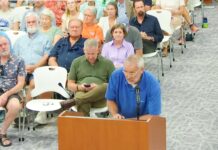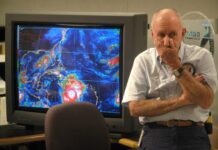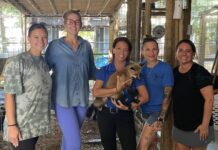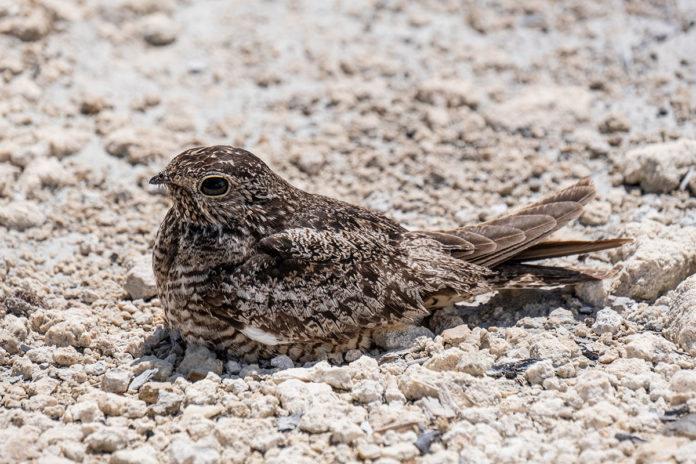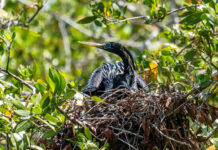Pedaling down Whitehead Street on the way home from the Green Parrot the other night I was pointing out all the nighthawks flying overhead in the last of the crepuscular light. By the time we passed the lighthouse and the Hemingway House there’d been about 30 or 40 of them, zipping around in that unique nighthawk way, meaning they’d be on an easy glide in one direction, then suddenly change direction and dart after something. Then they’d change direction and glide, then change direction again. No trajectory looked to be longer than six or eight yards before it was abandoned.
It’s how nighthawks feed – flying in an erratic, seemingly random pattern with their disproportionately large mouths open, gulping down bugs.
“They’ve all got to be common nighthawks,” I said. “Migrants. All the local Antillean nighthawks bugged out a couple weeks ago.”
My wife did a really good job of pretending she was interested.
If you spend enough time in the Keys, wandering around, looking for birds, it’s the kind of thing you expect to see in the fall, when thousands of birds migrate through here, though it will still inspire you to natter on to your spouse about what a cool sight it is, no matter how many times you’ve seen it, or how many times she’s heard you natter.
The unexpected nighthawk-related thing this season was the text I’d received from Chris Bergh a few days before, in which he told me he’d seen a nighthawk on the ground at a local park, and that there was a “big fuzzy chick” next to it. He gave some specific instructions about where the birds were, including “hiding in the shade of a wax myrtle.” He ended the text with, “If you’re into that sort of thing.”
If it were anyone else I would be sure they were mistaken, that while they thought they saw a fuzzy nighthawk chick, it was more likely a large pile of lint that escaped from a nearby clothes dryer, or maybe a baseball that had lost its cover, or, at best, a plush toy dropped by a child. Because any nighthawk chick born in the Keys should have fledged weeks, or even months, ago.
Bergh is the South Florida program manager for the Nature Conservancy, which is a nice credential, but more to the point, Bergh grew up here, and still revels in the wonders of this place. And I don’t think I know anyone with a better, fuller, more holistic understanding of Keys ecosystems and how they work, as well as all the various ways they are imperiled, than him. And if he said he saw a nighthawk chick in September – so (freaking) late in the season – he no doubt did.
I stopped by the park to look for the chick a couple days later. Ellen Westbrook was with me and we spent about half an hour wandering around, going, “What does a wax myrtle plant look like again?” and generally suffering in the heat. I tried to look up what a wax myrtle looked like on my phone, but the screen couldn’t compete with the fusillade of lumens the sun was throwing at us, so we bailed and continued on up the Keys.
We’re not quitters, though, so we stopped again on the way south. We crunched slowly across the gravel, inspecting the root of every tree and bush we saw. Nothing. Until we walked too close to a picnic table and a brown blob leapt out from beneath, then landed about 10 feet away, staring at us with half-opened eyes.
It would seem like a dumb move for a bird to make so little effort to get away from us, but it was actually a bit of avian cunning, a classic example of a distraction display. Nighthawks are known for them, and this one looked to be a common nighthawk, one of the two species that breed here in the Keys. She was trying to look vulnerable, so if we were predators, we’d move toward her. Then she would jump a short distance away again, hoping to draw us even further from the original site.
But we weren’t predators, we were birdwatchers, and we both froze, then looked in the shadow of the picnic table from whence she came. And there it was, a small fuzzball of a chick – the thing she was trying to distract us from – just sitting there. It was about a third the size of its mother, covered in gray down, but it stared at us with the same half-open eyes.
Nighthawks don’t build nests. They lay their eggs in a scrape on the ground, often right out in the open. They count on their cryptic plumage to camouflage them, and if someone gets too close, they do the distraction display. The females do the brooding, but the males are often close by, keeping an eye on things, and if the distraction display doesn’t work, they will do a thing called booming, where they fly incredibly close to you, and then change direction quickly, creating a little vortex of air that can be amazingly unsettling. (The first time it happened to me I was convinced, at first, there were bullets whizzing by.)
Adult nighthawks don’t really walk much, but the chicks are precocial, and can walk within 24 hours of being born. While brooding their eggs, females will actually adjust their position throughout the day and keep their back toward the sun. When the chicks hatch, they will often find refuge in the shade to keep cool, but also to be less visible.
Why the nighthawk was raising a chick this late in the season was hard to say. It might have been a second clutch. Or even a third one. In northern climes, birds tend to raise their chicks as soon as possible, and migrate once food begins to get scarce. But things get less clear the farther south you travel. Some species time their breeding and migration to the length of the day and the angle of the light. Some species seem to have hard-wired internal calendars. The mechanisms by which birds time their breeding and migration are still largely unknown.
What Ellen and I did know, though, was that these birds needed as little stress in their life as possible, especially as they were in the middle of a pretty popular park. So we got some good looks, took a few pictures, then backed away slowly, wishing them both the best of luck.


